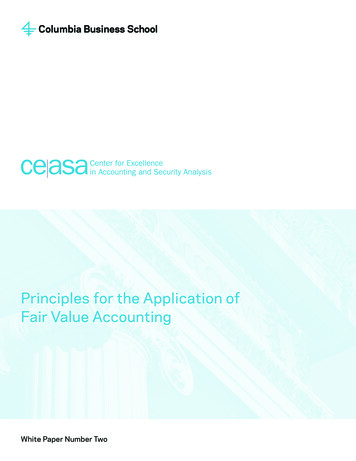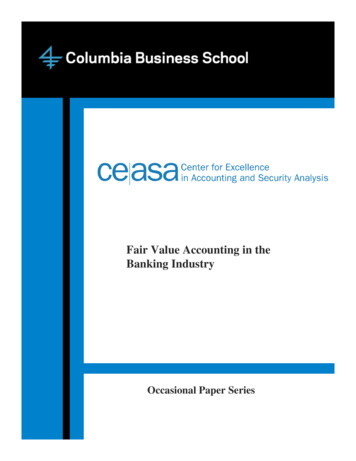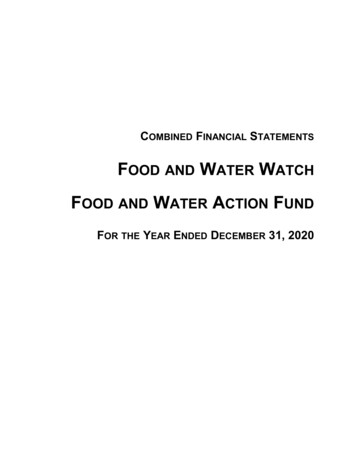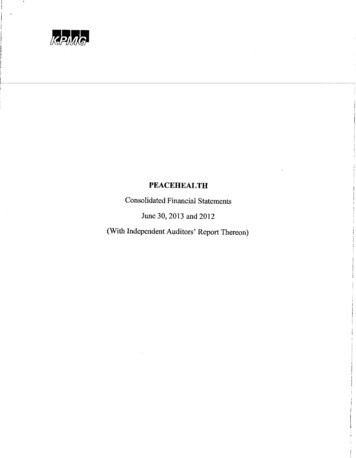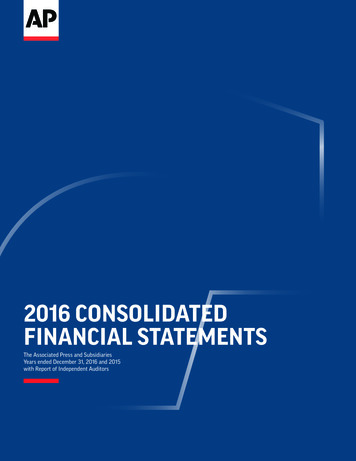
Transcription
Fair Value Accounting for Liabilities and Own Credit RiskMary E. BarthGraduate School of BusinessStanford UniversityLeslie D. HodderKelley School of BusinessIndiana UniversityStephen R. StubbenGraduate School of BusinessStanford UniversityMay 2006This paper has benefited from helpful discussions with Stephen Cooper and Jim Wahlen. Wewould also like to thank workshop participants at the Bank for International Settlements,Brigham Young University, Harvard Business School, Hebrew University, The InterdisciplinaryCenter at Herzliya, London Business School, UCLA, University of Tennessee, and Tel AvivUniversity for insightful comments and suggestions.
1. IntroductionCredit risk measures reflect common, priced risk factors that influence both debt andequity returns. Higher credit risk levels are associated with higher expected equity returns(Vassalou and Xing, 2004). Unexpected increases in credit risk are associated with negativerealized equity returns (Holthausen and Leftwich (1986). We refer to these established firstorder effects as “direct.” The objective of this study is to empirically test whether changes inequity value also reflect attenuating gains and losses associated with changes in debt value thatarise from changes in credit risk. Merton (1974) establishes these second-order effectstheoretically; however, empirical evidence is lacking.Our research question is relevant to the use of fair value accounting for liabilities, whichwould include recognizing in income, what some view as anomalous effects on equity value ofcredit risk changes. In particular, we test whether increases (decreases) in credit risk areassociated with incremental increases (decreases) in equity values, after controlling for the directeffects of risk changes on equity values. Because fair value accounting for liabilities, if adopted,would apply to all firms, we conduct our tests on a broad sample of primarily solvent firms. 1 Wealso calculate and provide descriptive evidence relating to the effects on firms’ financialstatements of recognizing changes in debt value.Changes in credit risk may arise when either the value or the risk of the firm’s assetschanges. 2 Merton (1974) shows that changes in equity value occasioned by changes in assetvalue and changes in asset risk can be characterized into potentially countervailing direct and1For ease of exposition, we discuss increases in equity value associated with decreases in debt value arising fromincreases in risk. However, the same arguments, and our empirical tests, also apply to decreases in equity valueassociated with increases in debt value arising from decreases in risk. We use the term solvent to mean that thevalue of the firm’s assets exceeds the book value of its debt.2Changes in credit risk also can arise from changes in financing risk, i.e., leverage, that are unrelated to changes inthe value of operating assets. Our analysis holds the face value of debt constant.
indirect effects. The direct effect of changes in asset value comprises the one-to-one mappingbetween asset value and equity value that exists in the absence of debt. The direct effect onequity value of increases in asset risk is negative or zero. It is negative if the risk is systematicand decreases asset value; it is zero if the risk is unsystematic and not priced. The indirecteffects of changes in asset value and asset risk are countervailing and comprise the amount ofany asset value change that is absorbed by debt holders, plus the change in debt value associatedwith changes in asset risk.Merton (1974) predicts that debt value changes with asset value, despite the maintainedassumption that debt has priority over equity. This prediction applies even to solvent firmsbecause priority at liquidation of the debt does not imply that debt holders have first claim onasset value before liquidation. Thus, debt holders participate in changes in asset value, evenwhen asset value is more than sufficient to liquidate the debt. Merton (1974) also predicts thatdebt value decreases with unanticipated increases in asset risk. Because equity value equalsasset value minus debt value, decreases in debt value result in increases in equity value.Therefore, the indirect effect on equity value of increases in asset risk is positive. Figure 1summarizes the direct and indirect effects of asset value and risk changes on equity. Figure 1shows that debt in the capital structure attenuates both the effects of asset value changes and riskchanges.Although there is abundant evidence that debt and equity prices respond directly tochanges in credit risk, we empirically test the second-order predictions of the Merton (1974)model because prior studies do not document gains (losses) to equity holders from decreases(increases) in debt values across a broad sample of solvent firms. Generalization of results fromexisting studies examining wealth transfers between debt and equity holders is limited by their2
small sample sizes and selective contexts. Analytically, Merton (1974) does not consider theeffects of institutional features such as market inefficiencies or debt covenants, either of whichcould limit equity holders’ ability to realize pre-liquidation gains from decreases in debt value inreal markets. As well, because Merton (1974) shows that the indirect effect on equity value ofrisk increases decrease with solvency, the effect might be negligible for many firms. Thus, testsbased on a broad sample of primarily solvent firms provide insight into the importance of theeffect for most firms.Understanding how changes in credit risk affect the values of debt and equity is critical tothe debate about using fair value accounting for liabilities. The conceptual frameworks of theFinancial Accounting Standards Board (FASB) and the International Accounting StandardsBoard (IASB) provide for income recognition of gains and losses arising from changes in therecognized amount of debt. Thus, if debt is recognized at fair value, firms will recognize gains(losses) when the fair value of debt decreases (increases). This is counterintuitive to some andhas generated controversy relating to financial reporting for liabilities. 3 Also, assets andliabilities are accounted for using different conventions. To the extent that recognized decreasesin debt value are not offset by recognized decreases in asset value, firms with deteriorating creditquality will recognize net gains. Concern about recognizing such gains is the primary reason theEuropean Commission endorsed International Accounting Standard (IAS) 39 (IASB, 2003) foruse by European firms only after deleting the option for firms to use fair value accounting forfinancial liabilities. The European Commission did not delete the corresponding option forfinancial assets.3This effect also runs counter to the traditional financial statement analysis view that leverage exacerbates the effecton equity return of realized return on assets (ROA). A realized ROA higher (lower) than the cost of debt, increases(decreases) realized return on equity. However, this obtains unambiguously only if the cost of debt is not equal tothe total return on debt (ie. the cost of debt excludes changes in the value of debt).3
We focus our study on documenting empirically the indirect effect on equity value ofincreases in risk. Thus, we test the prediction that the decrease (increase) in equity valueassociated with an increase (decrease) in risk is mitigated to the extent of debt in the firm’scapital structure, i.e., the firm’s leverage. Specifically, our tests focus on the relation betweenannual equity returns and the interaction between risk changes and leverage. Our proxy forchange in risk is change in estimated bond rating. Bond ratings reflect bond rating agencies’assessments of total credit risk; higher bond ratings reflect more risk. Risk changes interactedwith leverage provides a link between equity returns and debt values. If equity market valuechanges are associated with debt value changes, the relation between equity returns and changein risk will depend on leverage.Holthausen and Leftwich (1986) finds that equity returns are negatively associated withbond rating changes; we expect the same relation. However, we expect that equity value alsoreflects benefits associated with decreases in debt value. Thus, we predict that the interactionbetween leverage and change in credit risk is positive. We include earnings, change in earnings,and the level of leverage as control variables in our estimation equations. We expect equityreturns to be positively related to earnings and changes in earnings; we do not predict the sign ofthe association with leverage.Consistent with our predictions, we find that the association between change in equityvalue and change in risk is significantly less negative when leverage is higher. Because ofpotential nonlinearities, we also estimate the relation separately for firms with credit downgradesand upgrades. We find that downgraded firms have significant negative equity returns, aftercontrolling for leverage, earnings, and changes in earnings. More importantly for our researchquestion, we also find, as predicted, that returns are significantly less negative when leverage is4
higher. As predicted, we find the opposite for upgraded firms – although their equity returns areincrementally significantly positive, returns are significantly less positive when leverage ishigher. We also permit the estimation relation to differ depending on whether the upgrade ordowngrade is within investment grade, between investment grade and non investment grade, orwithin non investment grade. We find a significant positive relation between returns and changein credit risk interacted with leverage for each group, except for downgrades within investmentgrade.Because change in credit rating reflects asset value changes as well as asset risk changes,we test separately whether changes in equity cost of capital and changes in expected future cashflows are attenuated by debt in the capital structure. This design allows us better to separate theeffects of risk from the effects of asset value changes. Consistent with our primary results, wefind that leverage interacted with change in risk attenuates the effects of asset value changes andof asset risk changes.To provide a more direct link between changes in equity value and changes in debt valueassociated with changes in credit risk, we estimate the change in debt value incident to thechange in firm’s credit ratings and use it in our estimating equation in lieu of the risk change andleverage interaction variable. The change in debt value we calculate results from the change inmarket interest rate associated with the change in the firm’s estimated bond rating over thematurity of the firm’s debt. Consistent with our primary findings, we find that the gain or loss toequity holders from the calculated debt value changes is significantly positively associated withequity returns.We supplement our primary analyses by providing descriptive evidence on the financialstatement effects of fair value accounting for debt by using observed stock prices and volatility5
to invert the Merton (1974) model to obtain estimates firms’ asset volatility, asset value, and debtvalue. 4As expected, if only unrecognized changes in debt value are recognized, most upgradefirms would recognize lower net income and most downgrade firms would recognize higher netincome than under current accounting rules. Yet, for most firms, the difference is not largeenough to change the sign of net income. Also, our evidence indicates that for downgrade firms,asset write-downs recognized in accordance with present accounting standards are larger thanunrecognized gains from decreases in debt value. These findings call into question concernsabout anomalous income effects that are predicated on the assumption that debt value decreasesexceed recognized contemporaneous asset value decreases.The paper proceeds as follows. Section 2 elaborates on the background, motivation, andrelated research that underlie the study. Section 3 describes the basis for our prediction of therelation between equity returns and change in risk, and the research design we use to test it.Section 4 presents the primary findings, and section 5 presents results from additional analysis.Section 6 presents results relating to the financial statement effects of using fair value accountingfor debt, and Section 7 offers concluding remarks.2. Background, motivation, and related research2.1. Risk, debt values, and equity valuesDebt holders demand compensation commensurate with the level of risk they assume.Thus, changes in credit risk subsequent to debt contracting can affect the value of debt. Thevalue of debt changes when the market interest rate commensurate with the new level of riskdiffers from the rate determined at the inception of the debt. A large body of finance literature4We validate these estimates by estimating the relation between equity returns and changes in estimated asset valueand asset volatility, and the interaction between each of these and leverage. As expected, we find change in assetvalue is positively associated with equity returns. Consistent with our primary findings, we also find the relation6
focuses on explaining changes in debt values, particularly variation in observed credit premiumsacross traded bonds with different default risk. However, little of this research addressesempirically the interrelation between debt and equity value changes. Thus, the empirical validityof Merton’s (1974) predictions of equity gains from debt value decreases remains largelyunexplored.Structural debt valuation models are based on Merton’s (1974) insight that equity can beviewed as a call option on the value of underlying assets with a strike price equal to the faceamount of the outstanding debt. These models specify default risk and debt prices as a functionof operating risk attributable to assets, financial risk attributable to leverage, and the term of thedebt (e.g., Duffee, 1996, 1998; Duffie and Singleton, 1999; Huang and Huang, 2003; see Bohn,2000, for a review of this literature). 5 Related to the effects on debt value of changes in defaultrisk, Strong (1990) investigates changes in debt value associated with changes in bond rating fora sample of 190 firms in 1983. Strong (1990) seeks to distinguish changes in debt valueassociated with changes in firm risk from those associated with changes in market risk, and findsthat both explain debt value changes. However, this literature does not attempt to link debt valuechanges and equity value changes.The first-order effect on equity value of changes in default risk is well-established.Holthausen and Leftwich (1986) and Hand, Holthausen, and Leftwich (1992) investigate changesin equity value associated with announcements of bond rating changes. These studies find thatbetween equity returns and change in asset value (asset volatility) is significantly less (more) positive when leverageis higher.5We use the term “credit risk” to describe unobservable factors that determine the risk premium on debt at anypoint. Because we assume that contractual debt cash flows do not change prior to maturity, declines in debt valuemust derive from increases in credit risk. The terms “credit risk”, “default risk’, “firm risk”, and “total risk” oftenare used interchangeably in the finance and accounting literatures that we cite. For the most part, these terms areconsistent with our usage of “credit risk.” One exception is term “default risk” which may be more narrowlyconstrued. Specifically, although all firms have credit risk, some authors argue that only firms with non-zero debthave default risk (Dhaliwal, Lee and Fargher, 1991).7
debt and equity returns decrease with bond rating downgrades, consistent with bond ratingdowngrade announcements conveying net negative information both to debt and equity markets.Dichev and Piotroski (2001) finds that negative abnormal equity returns persist for up to threeyears following bond rating downgrades and attributes this persistence to the marketunderreaction. However, Vassalou and Xing (2003) shows that these future abnormal returnslargely disappear after taking account of serial downgrades and the variation in default riskaround downgrades.Relatedly, Ederington and Goh (1998) finds that analysts decrease earnings forecastsfollowing downgrades and attributes this finding to information transfer from debt ratingagencies to equity analysts. Consistent with credit risk comprising common factors thatinfluence debt and equity returns, Vassalou and Xing (2004) shows that a large portion of defaultrisk is systematic and, thus, priced in equity value. However, none of these studies examines thepotential attenuating effects of debt value changes on equity value changes when commonfactors cause both to change.A few studies examine the interrelation between change in debt value and change inequity value. In a unique institutional setting, Kliger and Sarig (KS, 2000) examines changes instock and bond prices incident to Moody’s 1982 adoption of finer rating partitions. KS findssignificant decreases in bond prices for firms with implied downgrades, but does not consistentlyfind significant increases for firms with implied upgrades. The significance of equity returns byrating change group depends on the specification; KS finds no positive abnormal equity returnsto downgrades when basing expected returns on a market model. Hand, Hughes, and Sefcik(HHS, 1990) investigates whether bond holders gain at the expense of stock holders when firmsdefease debt in substance, but not legally, for a sample of 80 defeasances by 68 firms from 19818
to 1987. For a subsample of these firms with announcement data, HHS finds significant positivebond returns at the announcement of the defeasances and significant negative stock returns.However, the negative correlation between bond returns and stock returns is weak. After alsoinvestigating motivations for the defeasances, HHS concludes that the negative announcementstock returns are more likely attributable to information effects than to increases in debt valuesresulting from decreases in equity values. Each of these studies provides suggestive results,however the uniqueness of the settings and small sample sizes limit generalizability.Another related stream of research examines whether debt attenuates the response ofequity to earnings announcements. 6 Dhaliwal, Lee, and Fargher (1991) show that firms withhigher leverage have lower earnings response coefficients (ERC) and posit that equity holders inmore highly levered firms receive a smaller share of the change in firm value associated withunexpected earnings. Dhaliwal and Reynolds (1994) shows that ERCs are negatively related todefault risk measured by bond rating level. Dhaliwal, Lee, and Fargher (1991) suggests thatfuture research can enhance the tests relating to the effects on equity value of changes in assetvalue by using changes in default risk proxies, rather than levels. These studies establish theeffect of risk level on equity’s response to reported GAAP earnings; we examine the effect ofleverage on equity’s response to credit risk changes.2.2. Fair value accounting for debtThe FASB has identified fair value as the most relevant measurement attribute forfinancial instruments and has indicated that recognition of all financial instruments at fair value6Another stream of research links debt value and equity value by simulating the potential magnitude of agency costsarising from risk-taking incentives identified in Merton (1974), for example, Parrino and Weisbach (PW, 1999).Analytic analysis and simulations such as those in PW suggest that the agency costs can be substantial. However,PW assumes the Merton (1974) model when constructing simulated debt value, and, it cannot test the model’spredictions. Empirically, Odders-White and Ready (OR, 2006) finds that firms with lower credit ratings have higheradverse selection components in their equity spreads, suggesting that agency costs are priced in expected equity as9
is one of its long-term goals (FASB, 1999). Fair value measurement is permitted in US andInternational GAAP for many financial assets (e.g., Statement of Financial Accounting Standard(SFAS) No. 133 and IAS 39). However, fair value measurement of liabilities is not widespread.SFAS 133 and IAS 39 require derivative liabilities to be recognized at fair value, but require orpermit firms to recognize at historical cost other liabilities, including long-term debt.Fair value recognition of liabilities, particularly long-term debt, is a controversy currentlyfacing standard setters. Many believe that recognition of liabilities at fair value is consistent withadoption of a fair value measurement basis for assets. A large body of research supports thenotion that both reported income and its volatility better reflect market and other risks whenfinancial firms recognize financial assets and liabilities at fair value (see, e.g., Barth, Landsman,and Wahlen, 1995; Hodder, Hopkins, and Wahlen, 2006).However, others find the prospect of recognizing changes in debt fair value disturbing.They are particularly concerned about financial reporting implications if changes in debt valuerelated to changes in the firm’s own risk are recognized. For example, the European CentralBank has called the recognition of gains associated with increases in risk “counterintuitive”(European Central Bank, 2001). The European Commission’s endorsement of IAS 39 for use byEuropean firms eliminated the fair value recognition option for financial liabilities. The concernstems from the potential for net income to reflect poorly changes in the value of the firm’s netassets if decreases in asset values are not recognized concurrently with decreases in debt values.For example, if some intangible assets are not recognized, troubled firms could report net incomewell as debt. However, OR does not test the relation between changes in debt value and changes in equity valueincident to unexpected increases in risk or decreases in asset value.10
from recognized decreases in debt value during periods in which they experience decreases inequity value. 7Lipe (2002) demonstrates how accounting ratios might convey misleadingly positivesignals when a firm approaching bankruptcy uses fair value accounting for liabilities. Lipe(2002) concludes that changes in debt value attributable to changes in credit quality should notbe recognized. However, the adverse financial statement effects of Lipe’s (2002) exampleprimarily derive from incomplete recognition of assets and changes in asset values, not from thepro-forma recognition of changes in debt value.Balance sheet and income statement recognition of risk effects at inception is notcontroversial. Both the carrying value of debt and recognized interest expense reflect debt’scredit rating when issued. In contrast, fair value accounting measures and recognizescontemporaneously the effects of any changes in risk or market interest rates. Barth andLandsman (1995) notes that recognizing these changes is appropriate because debt holders havecommitted to an interest rate that is not commensurate with the ex post level of risk. Fair valueaccounting recognizes subsequent interest expense at the new rate, reflecting the change in thedebt holders’ required compensation. The promised stream of cash flows is unchanged and,cumulatively, only the characterization of income cash flows between gain or loss and interestexpense changes. Fair value accounting ensures that periodic interest expense reflects thecurrent cost of borrowing and excludes the benefits (costs) of below-market (above-market)borrowing resulting from prior-period debt transactions.7When risk decreases, increases in asset values often are not recognized. Yet, if debt is recognized at fair value,increases in debt value would be recognized as losses. When risk increases, the opposite occurs. Recognized assetsmay be written down. However, not all assets are recognized and asset write-downs may not be complete or timely.Because debt values are less sensitive to decreases in risk than to increases, the latter problem is more troublesometo regulators than the former.11
Although there is a substantial literature addressing the value-relevance of fair values forequity prices and returns, few of these studies examine fair values of liabilities in industries otherthan banking and insurance. Banking industry studies consistently demonstrate the valuerelevance of asset fair values and to a lesser extent, deposit liabilities and long-term debt fairvalues. For example, Barth, Beaver, and Landsman (BBL, 1996) finds that unrealized gains andlosses on bank long-term debt are significantly associated with the difference between equitymarket value and book value, although not in all model specifications and years. BBL finds nosignificant association between changes in unrecognized unrealized gains and losses on longterm debt and changes in the difference between equity market value and book value. Eccher,Ramesh, and Thiagarajan (1996) and Nelson (1996) find no association between equity valueand long-term debt fair value. For a sample of non-financial firms, Simko (1999) finds thatliability fair values are associated with equity values, but not consistently across industries andyears. Barth, Landsman, and Rendleman (BLR, 1998) estimates debt values for a sample of nonfinancial firms and investigates the financial statement effects of fair value accounting for debt.BLR finds that financial statement amounts using fair value accounting for debt are potentiallyrelevant to investors because financial statement amounts would be substantially different fromthose currently recognized. However, none of these studies investigates the effects of changes incredit risk on the value of the firm’s debt and equity.3. Basis for prediction and research design3.1. Basis for predictionWe expect the effect on equity value of changes in credit risk to depend on the amount ofdebt in the capital structure. Merton (1974) shows that changes in equity value reflect twocountervailing effects, a direct effect and an indirect effect. The direct effect is a function of12
changes in asset value; equity value decreases as asset value decreases. Changes in asset riskaffect asset value only to the extent that the risk is systematic and the change is unanticipated.As such risk increases, asset value and, thus, equity value, decreases. Changes in unsystematicrisk have no effect on asset value and, thus, have no direct effect on equity value. Thus, in theabsence of debt, increases in risk have no positive direct effects on equity.The indirect effect of risk on equity value is a function of factors that affect the value ofdebt, including leverage, asset value, and asset risk. Holding leverage constant, the indirecteffect comprises the amount of asset value change that is absorbed by debt holders plus thechange in debt value associated with changes in asset risk. Merton (1974) predicts that, despiteassuming priority of debt over equity, debt value is increasing in asset value, even for solventfirms. Specifically, the value of levered equity is a convex function of asset value with a slopethat approaches one only in the limit. This suggests that debt value varies with asset value,thereby mitigating the effect on equity value of changes in asset value. Merton (1974) alsopredicts that debt value decreases with increases in systematic and unsystematic asset risk.Because equity value equals asset value minus debt value, changes in debt value result inchanges in equity value, even when asset value is unchanged.The indirect effects are those that some view as counterintuitive. Thus, we test theprediction that the decrease (increase) in equity value associated with an increase (decrease) incredit risk is mitigated to the extent of debt in the firm’s capital structure.3.2. Research design: Returns and risk changesWe estimate in Eq. (1) the relation between equity returns and change in credit risk.RETt β 0 β1ΔCRt β 2 ΔCRt DBTAt β 3 DBTAt β 4 EPS t β 5 ΔEPS t β 6 NEGt β 7 NEGt EPS t β 8 NEGt ΔEPS t ε 1t13(1)
RET is annual size-adjusted stock return, inclusive of dividends. DBTA is the end-of-year ratioof book value of long-term debt to book value of total assets. EPS is earnings per share beforeextraordinary items, deflated by beginning-of-year stock price. NEG is an indicator variable thatequals one if EPS is negative, and zero otherwise. Δ denotes change and t denotes year; we omitfirm subscripts. We use only accounting-based explanatory variables in equation (1) to avoidendogeneity associated with changes in market values.ΔCR is the annual change in our proxy for credit risk, CR, where CR is a categoricalvariable that ranges from 1 denoting low risk to 4 denoting high risk. Thus, ΔCR is positive(negative) when credit risk increases (decreases). CR is the firm’s bond rating, which weestimate based on the relation between actual bond ratings for firms with rated debt andaccounting variables. The appendix explains how we follow prior research to do this. We useactual bond ratings to develop CR because bond ratings reflect the credit agency’s assessment ofthe firm’s risk, where that assessment is based on publicly available and private information(Jorion, Liu, and Shi, 2004). For consistency, we use estimated bond ratings to construct CR forall firms. Using estimated bond ratings permits us to expand our sample beyond firms with rateddebt, thereby enhancing the generalizability of our inferences. Also, bond ratings, especiallyupgrades, are revised with a lag (e.g., Pinches and Singleton, 1978), which adds noise whenobserved bond rating changes are used as proxies for changes in ris
Credit risk measures reflect common, priced risk factors that influence both debt and equity returns. Higher credit risk levels are associated with higher expected equity returns (Vassalou and Xing, 2004). Unexpected increases in credit risk are associated with negative realized equity returns (Holthausen and Leftwich (1986).
